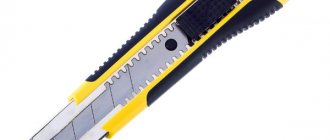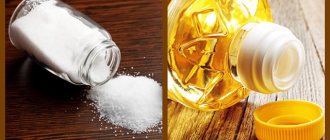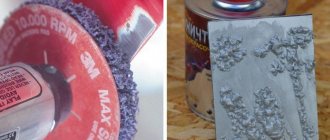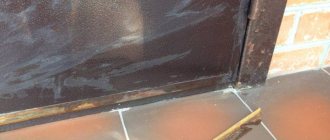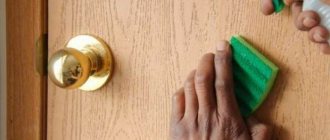Professional mounting foam TYTAN 65 750ml. Stroylandia Photos
Polyurethane foam is used in a number of construction and repair work: sealing cracks, installing waterproofing, etc. Foam is most popular when installing plastic window blocks and door frames. Despite the convenience and ease of use, some difficulties may arise . For example, when applied, foam can get on work surfaces, in particular: metal doors and plastic windows, clothing, and skin.
Reasons for hitting the door
Installation of door frames of various types involves the use of polyurethane foam to fix the structure and seal gaps and voids . Excellent performance characteristics and ease of application have made foam a popular building material. But when using it, sometimes unforeseen situations happen . Careless handling of polyurethane sealant leads to a certain amount of the composition getting onto the canvas, which can lead to damage to the integrity of the coating and loss of its original appearance. This can happen for several reasons:
Foam Soudal Construction and Repair 500 ml. Photo Petrovich
Little experience of the work performer leads to incorrect determination of the required amount of mixture coming out of the cylinder. When expanding, the composition increases significantly in volume, the excess protrudes from the gap and ends up on the canvas or additional parts.
Use of household foam , produced in cylinders with a plastic tube. This mechanism (unlike a professional pistol) does not allow you to control the exit speed and foam consumption . When the valve is closed, the mixture continues to flow from the cylinder for some time. Careless pressing of the valve may result in spraying of the composition. When the foam runs out, it comes out of the container in jerks along with the remaining gas , the spray flies out of the container at high speed and hits not only the surface being treated, but also the surrounding elements.
Using low-quality foam will most likely lead to unsatisfactory results. Therefore, regardless of the complexity and responsibility of the work, it is recommended to choose products from well-known brands, for example, TECHNONICOL, Makroflex, Soudal, Tytan. And purchases must be made from trusted trading companies.
Thus, before you start doing the work yourself, you need to find out how it is possible to remove foam from the entrance and interior doors.
How to deal with dried polyurethane foam
The main characteristic of polyurethane foam is its ability to stick almost instantly and harden very quickly. After polymerization, it is no longer possible to wipe it off with acetone or white spirit. What can be done about unwanted contamination in this case?
There is no need to despair, there is a way to save the door, but you will need to be patient - the process is painstaking and slow.
- First you need to cut off as much of the dried foam as possible with a sharp razor, wallpaper knife or regular kitchen knife. It is not recommended to use a stiff brush, sandpaper or wire mesh - they will leave marks even on a metal door.
- Next, you need to moisten a cotton sponge in the Dimexide solution. For those who don’t know, this is an acid-containing drug, colorless and almost odorless, which is used in medicine as a strong antiseptic, anti-inflammatory, and absorbent agent. Dimexide is able to destroy the molecular bonds of polyurethane foam and thus dissolve even very old traces of sealant.
- A tampon soaked in Dimexide is applied to the mounting foam for 10 minutes. This time is enough for the stain to soften, and now it can be easily removed with an old toothbrush or the hard side of a dishwashing sponge.
Attention: Dimexide may also not be suitable for covering your damaged door with polyurethane foam. If the sensitivity test is not passed, then Dimexide will also have to be abandoned.
This does not mean that now you will have to live with a door stained with building materials and explain yourself to guests every time. there is still a way out.
Users are advised not to give up and remove the remaining polyurethane foam mechanically - that is, using a variety of hard brushes, sponges and abrasives. This could be baking soda or dish cleaning powder. The main thing is to persistently rub, rub and rub again. Sooner or later the marks will go away and the door leaf will become clean again.
How quickly it dries
The properties of polyurethane foam are important not only at the stage of analysis and selection of the optimal option , but also during the execution of work. Question: How long does it take for polyurethane foam to dry? - is also relevant when the composition gets on a surface not intended for it . After all, depending on when the foam got on the canvas, the means for removing it differ.
Household mounting foam Makroflex 500 ml. SHAKETEC. Photo by Maxidom
A feature of polyurethane sealant is its ability to polymerize, i.e. completely harden within 8-12 hours from the moment it comes out of the container. Fresh foam is much easier to remove and can be done without the use of special tools, using improvised materials.
Cleaning glass and decorative inserts of interior doors
Often interior doors are made with clear or frosted glass inserts. Undoubtedly, this decorates the appearance of the product, but accidental splashes of polyurethane foam significantly spoil the impression. Any remaining product must be eliminated as soon as possible. For these types of surfaces, the oil method is suitable. The steps are as follows:
- Use a knife to cut off the top of the foam.
- After this, vegetable oil is applied on top for 15 minutes, which also has the ability to soften the sealing agent.
- Then the dirty area should be rubbed with a kitchen sponge. When the foam is completely removed, the oil trace is removed using a soap solution.
You can use oil to remove recently dried polyurethane foam. For old stains, this method will not be effective. It is also undesirable to use oil to clean wooden surfaces, veneer and MDF, as this will lead to the appearance of ugly stains on the door, which are almost impossible to get rid of.
Using Soudal PU REMOVER paste
Long-hardened foam is removed from glass and other non-porous surfaces using Soudal PU REMOVER paste. This product is a mixture consisting of solvents and plasticizers. The paste leaves no residue and is odorless. It is applied with a brush, which is sold in the kit. After 20 minutes, the foam is removed with a spatula.
How to clean at home, options for improvised means
Success in the fight against fragments of polyurethane foam largely depends on the efficiency of the work . The sequence of actions depends on how much time has passed from the moment the composition hits the surface until the moment it is detected:
- The first situation is when the foam has not polymerized, which ensures traceless removal of contamination.
- The second situation , an already frozen fragment of polyurethane was found on the canvas. In this case, the forecasts are less optimistic. There is a high probability of either incomplete removal of the composition or damage to the surface and damage to the decorative coating.
Therefore, when using foam, it is important to carefully monitor the cleanliness of surrounding surfaces . And if necessary, immediately remove the composition while the process of hardening and polymerization is underway. The formation time of the surface film is about 20-30 minutes, during which time the work must be completed. Measures taken in time will allow you to limit yourself to the use of improvised means and save money, since you will not have to buy special substances (cleaners).
Advice. The foam has high adhesion, i.e. Excellent adhesion to many building materials. Therefore, during the work, it is recommended to protect with film those areas of the structure that may be exposed to the composition. This will save time, effort and money on cleansing. The protective film is not a 100% guarantee of cleanliness, since droplets of foam can still get into certain areas; even experienced craftsmen are not immune from this, but small stains are easier and faster to remove.
What can you use to clean an iron or wooden door if it hasn’t hardened?
A special feature of polyurethane foams is their ability to harden quickly. However, there is time before polymerization. If the composition has not yet adhered to the surface, it can be removed using several tools and materials.
Important! Do not remove uncured foam with a wet cloth. Trying to wash off the polyurethane will make the situation worse, since contact with water will only speed up the polymerization process.
1) Spatula . To remove significant amounts of foam, it is recommended to use a plastic or wooden spatula. After which the surface must be wiped with a clean and dry cloth.
2) A scraper made of plastic or other material that will not damage or scratch the coating, if any. Residues of the composition are removed with a cloth soaked in a small amount of acetone or nail polish remover containing acetone.
Attention. Acetone is the most effective and inexpensive way to combat polyurethane foam. But due to the presence of potent components in the composition, acetone is used only for surfaces that are difficult to damage. Getting it on vinyl or plastic surfaces will only make the situation worse. It is not suitable for structures with a varnish coating. Using the product will cause it to wash away the foam along with the varnish or paint. Therefore, if there is no confidence in the safety of using acetone for construction, you need to abandon this product or conduct an experiment. Wipe an area inconspicuous to the eye with a rag and acetone and determine whether the surface is damaged.
3) A paper napkin soaked in slightly heated vegetable oil . It wipes the contaminated areas, which are then washed with warm water.
Set of plastic spatulas 50/100/150 mm, 3 pcs. Photo by Leroy Merlin
4) Soda . The small product is characterized by a gentle effect. It is enough to wipe the contaminated surface to remove the foam.
5) Vinegar . An essence is used to remove the mixture. A rag is soaked in it and the surface is wiped until the dirt completely disappears.
Remove if dried out
also possible to deal with frozen foam using improvised means . Removal of hardened composition is based on the dissolution of polymer chains . For this, special products and solvents . But weak substances are not able to cope with the task. It is necessary to use concentrated formulations . But we must not forget that they also affect the decorative coating of the door .
White spirit 1 l. Photo by Leroy Merlin
Therefore, first of all, it is necessary to try to remove the polyurethane mechanically . It is necessary to carefully select the tool so that it does not damage the structure or coating. The blade, knife and sharp spatula are suitable for cleaning surfaces made of wood, metal and varnished structures. For veneer doors, a wooden spatula should be used.
First, the upper part of the frozen mass is removed. After this, a thin adherent layer with a dense structure remains. It is quite difficult to completely remove the mass, so you will have to take additional steps.
Reference. Sometimes it is not necessary to remove the mixture immediately; it is advisable to wait until it dries completely. The frozen mass acquires a dense structure, which can be stronger than the adhesion force. As a result, there is a chance to remove the foam by tearing off a whole piece. It is recommended to remove residues with the hard side of a foam sponge or a rubber eraser.
It is possible to erase the remaining contaminants after removing the bulk of the polyurethane using special means. These substances are also used to remove small foam contaminants, i.e. without prior use of a mechanical method.
1) Solvents are first aid products. To remove polyurethane foam, products numbered 646 and 647 . The first is more aggressive, and therefore is only suitable for rough surfaces, for example, metal doors. For structures made of PVC and MDF, its use is strictly prohibited. The solvent is applied to a dry, light cloth, which is used to treat the contaminated surface. To achieve the best effect, it is recommended to leave for 10 minutes . The remaining product is removed along with the foam. The door needs to be washed.
Important! Carrying out work using aggressive agents requires protecting your hands with gloves. Lack of PPE can lead to injuries such as eczema or dermatitis.
2) Dimexide. This product does not belong to the category of building materials. It can be purchased at a pharmacy, since Dimexide is used to treat diseased joints. But in concentrated form, Dimexide successfully copes with frozen foam. To do this, you need to soak a sponge with Dimexide, rub the stain with it for several minutes (2-5), then you need to remove the remaining sealant with the rough side of the sponge or a toothbrush.
Reference. Dimexide does not destroy varnished and plastic surfaces. But white spirit, with prolonged contact with the varnish, penetrates its structure and leaves cloudy marks on the surface.
3) White spirit is an alternative to pharmaceutical Dimexide. It is an organic solvent obtained from oil refining. Allows you to completely clean the canvas from foam, without harm to the metal surface. A sponge or colorless material is impregnated with white spirit. The composition is applied to the stain and left for 2-5 minutes. The mass softens and is removed with a scraper or a brush with stiff bristles. Residues of polyurethane are washed off with clean water.
Attention. White spirit has a pungent odor. Therefore, work must be performed in a well-ventilated area and in a respirator.
4) Vinegar essence. For processing it is necessary to use concentrated acid; table vinegar will not cope with contamination. The procedure is as follows. Gloves must be worn. A dish sponge or rag is generously soaked in essence. The surface is treated with this composition and left for 15 minutes. The foam is removed with a spatula. The door is rinsed with clean water.
5) Cosmofen, Cosmofen 5, 10 and 20. The numbers reflect the strength of the product: the smaller it is, the stronger it is. Cosmofen5 is a substance well known to window installers. This is a polyvinyl chloride (PVC) polish with strong solvent properties. Cosmofen10 and Cosmofen 20 are window profile cleaners that remove fresh and hardened foam and are also suitable for working with doors.
Slightly soluble cleaner Cosmofen 10 1 l. Photo by Leroy Merlin
6) Ultraviolet. If the hardened foam is located on the outside of the front door, then you need to wait until the polyurethane is destroyed by exposure to ultraviolet rays.
How to wash off the fresh one?
A special feature of polyurethane foam is that it hardens quickly. However, there is still time until complete polymerization. If the sealant has not yet adhered to the surface, you can remove it in the following way:
Putty knife. If there is a lot of foam, remove most of it with a plastic or wooden spatula, and then wipe the surface with a clean rag.- A paper napkin soaked in vegetable oil . Use it to wipe the areas where the foam has gotten, and then rinse it with warm water.
- Solvent. The simplest and most accessible composition is acetone. To treat a small area, a few drops applied to a dry cloth are sufficient. If you don’t have pure acetone on hand, you can use nail polish remover.
Several factors influence the drying time of the sealant:
- quality of building material,
- its composition,
- air temperature,
- environmental humidity and more.
The average time for complete adhesion is 9 hours. However, at sub-zero temperatures this time increases to a day. If more than 24 hours have passed since the composition was applied, it cannot be easily removed.
Features of working with various materials
When removing foam, it is necessary to take into account the material from which it is made, since there are no restrictions only for metal surfaces . Therefore, when working with uncoated metal, it is possible to wait for the composition to polymerize and then calmly remove the contamination using a special product, solvent , Dimexide or any other product that must be left for 15 minutes. After this, the remaining mass is removed with a napkin or rag .
Polyurethane foam cleaner Tytan Prof Eco 0.5 l. Photo by Leroy Merlin
If foam gets on a nitrocellulose-based varnish coating, it will require restoration , since the finish will be destroyed upon contact. Alkyd and polyurethane varnishes are not afraid of balloon foam. Therefore, the uncured mass is carefully removed from the surface, and traces are removed with a rag soaked in acetone before drying. It is recommended to do the same with laminated door leaves.
But with dried foam everything is more complicated. The mass is not completely removed mechanically. A thin layer of polyurethane can be removed by trying to reduce the adhesion of the foam to the surface. For varnished surfaces, sunflower oil is used, which is used to lubricate the dirt and leave for a long time, Dimexide, and white spirit. But the latter leaves marks on the varnish.
wooden surfaces coated with varnish not immediately; it is recommended to wait until the mixture begins to harden, resembling rubber in consistency. Then it will be possible to carefully remove by prying up the edge. The mark remaining on the surface is removed with Dimexide, which must be moistened with a soft sponge and rubbed against the stain for a couple of minutes. The softened composition is removed with a hard sponge or toothbrush . A cleaner or other solvent may be used.
Eco-veneer is a composite material containing wood shavings and a synthetic binder. Dimexide can harm the fibrous structure of the structure. The material has sufficiently high mechanical strength, so it is possible to use soda. White spirit will also work, but leave it on for half a minute. The textured surface of the doors will require some effort to scrub off the mixture.
Marks on veneer doors can be removed using potatoes and talcum powder. Just rub the stain and wait for it to dry. The remaining mass is removed with a napkin. The surface is polished with talc. Veneered structures can be treated with a cleaner.
Attention. It is not recommended to use vegetable oil to clean structures made of veneer, wood and MDF.
To work with plastic doors, it is recommended to use table vinegar. It is applied to the uncured stain and the dirt is rubbed off. It is possible to use special cleaners. Dried foam can also be removed with Dimexide.
Glass inserts on interior doors are cleaned using an oiled rag. You can leave the vegetable oil for 15 minutes. Once the mixture becomes soft, remove it with a sponge. The trace of oil is removed with a soap solution. Solidified contaminants are removed using special or home remedies: oil, Dimexide, acetone.
PVC coatings are cleaned with Dimexide, and painted surfaces with vinegar.
How to clean varnished wood panels and MDF
It is more convenient to remove foam from a varnished door at the stage of hardening when it resembles rubber. In this case, it is enough to pull the edge and the dirt will fall away from the surface. If the desired result cannot be achieved, you need to use a cleaner. Dimexide, which can be purchased at a pharmacy, is suitable for this purpose. This product destroys the binding molecules of the sealant.
Dimexide is perfectly absorbed into the skin and has a detrimental effect on it. Therefore, the work is carried out with rubber gloves.
To clean wooden and MDF panels, do not use hard sponges or other abrasive materials. If you need to wipe off foam from a polished surface, Dimexide is also used. The process of cleaning doors with this product is simple:
- Carefully cut off any remaining foam with a knife as much as possible without damaging the surface.
- Moisten a rag or sponge with Dimexide and treat the stains for 1 - 2 minutes.
- When the sealant becomes soft, remove it with a sponge, a piece of hard cloth or a toothbrush.
It is recommended to first check the effect of Dimexide on the surface to be cleaned. To do this, apply it to the door in an inconspicuous place for 10 minutes. If after this time no light spots appear on the surface, you can begin treating the contaminated area.
Dimexide will quickly and safely remove foam residues from varnished and wooden doors
Video: master class on removing foam with Dimexide
Special means for removing dried mixture
It is possible to get rid of fresh and hardened polyurethane foam using store-bought products specially developed for this purpose. There are a significant number of substances on sale, for example:
Axton foam cleaner, 0.5 l. Photo by Leroy Merlin
Makroflex PREMIUM is a professional cleaner for removing uncured foam from various surfaces and fabrics;
Soudal offers several types of cleaners, one is designed to remove hardened mixtures, a paste-like product is used for door and window frames and frames made of chemically resistant materials, in particular aluminum and polymer materials;
KRAFTFLEX CLEANER from Kraftool , a cleaner designed to remove uncured foam from a gun, clothing and other surfaces;
PROFI STAYER removes uncured foam from guns, leather and other surfaces;
Penosil Premium Cured PU-Foam Remover is designed to soften hardened foam;
TECHNONICOL - cleaner from the PROFESSIONAL series is used to remove splashes from clothing, work surfaces or skin;
Tytan offers a multi-functional product for removing material residues and degreasing surfaces.
Attention. Enterprises offer a wide selection of special products. It is important to select a cleaner of the same brand as the polyurethane foam used.
The use of the cleaner should not cause difficulties for performers. Instructions for use are provided by the manufacturer. Enterprises also provide general recommendations regarding which surfaces can be treated with the product, how long it is safe to leave it on the surface, etc.
What products should NOT be used to clean the surface?
To prevent harm to your own health and not to damage the door, you must follow some rules and recommendations regarding the tools and means used:
- It is not recommended to use sharp spatulas and spatulas, they can easily damage the surface; scratches have not yet been adorned on more than one structure;
- Do not use abrasive powders, they leave abrasions;
- for metal doors there are no restrictions in the choice of means;
- for structures with decorative finishing, aggressive substances that can damage the structure cannot be used;
- It is prohibited to use solvents and acetone for plastic coatings;
- stains remain on wooden and veneer surfaces after applying oil;
- It is not recommended to use the solution with soap or powder.
How to remove dried foam from eco-veneer
Eco-veneer is a multi-layer material made from compressed wood fibers and a synthetic binder component. It imitates the texture, pattern and color of natural wood and has a smooth surface. Dimexide is not used in the case of doors made of such material, because it is absorbed and destroys the structure of the fibers. You can clean a veneer door as follows:
- First, clean the foam mechanically - using a knife, spatula or other convenient tool.
- Then wipe the surfaces with a damp sponge, and then treat with soda.
Eco-veneer is a material that is resistant to chips, scratches, impacts and other mechanical damage. Baking soda will not damage its surface.
As an alternative, it is possible to remove clumps of polyurethane foam with white spirit. To do this, apply the product to the desired location and leave for 30 seconds. After which the veneered canvas is cleaned with a dry soft cloth. A prerequisite is preliminary testing of the product on a small fragment of the canvas.
How to clean polyurethane foam with white spirit - video
What not to do to remove foam from a door leaf
Respirator Source FFP1 with valve. Photo by Leroy Merlin
When removing foam, you must remember several prohibitions:
- Work should not be carried out without personal protective equipment: gloves and a respirator;
- It is not recommended to cut the frozen mass with a knife to the very base, this increases the likelihood of damage to the canvas;
- Solvents and cleaners should not be left on the surface longer than indicated on the packaging, as this may damage the surface;
- Do not spread the foam over the surface; the composition must be removed with sudden movements;
- you should not try to wash off uncured foam, water only strengthens the adhesion of the mixture to the base;
- It is necessary to use a sponge of moderate hardness, but do not use a metal mesh, as it can damage the finish.
Removing cured foam
Cured sealant can only be removed using mechanical methods. The top part of the building material is cut off with a knife, blade or razor, and then the remaining clumps of foam are carefully scraped off. If there is a threat of surface damage, resort to the use of solvents.
The most accessible solution is acetone. It is suitable for cleaning durable materials, but is not used on laminated or varnished door leaves. Some substances can easily be found in your home or garage: nail polish remover, gasoline, white spirit.
All solvents are suitable for smooth surfaces, but does anyone know how to remove polyurethane foam from powder-coated doors. Just take a foam sponge and rub the dirty area with the rough side. The layer of powdered metal is susceptible to chemicals; the effect of these substances should be tested in inconspicuous areas. Do not wash off the polyurethane foam with water - this will speed up the hardening process.
Precautions to effectively remove the mixture
Polyurethane foam is a product that can penetrate deep layers of the base . This property is the reason for the difficulties that arise when removing the composition . In order to avoid difficulties and problems, before performing work, it is recommended to cover the surface of the canvas and the box with film and secure it with tape. The contractor also needs protection , especially if the work is carried out using aggressive means. Thick rubber gloves are used to protect hands . The use of products with a strong odor, such as acetone or white spirit, requires the performer to wear a respirator or gauze bandage . The effect of the substance on the material is checked on an inconspicuous area of the door. Just apply a few drops to the surface and wait 15 minutes. The absence of damage allows the product to be used for its intended purpose.
Precautionary measures
Foam is a substance with a high degree of adhesion. This means that the foam molecules penetrate deeply into the material and bind tightly to it.
Polyurethane foam is used to blow in cracks when installing doors
While installing the door structure and blowing in cracks, stick a protective film on those areas where the product may get in . This is better than then standing for hours and trying to wash off the frozen mass.
Protective film is not a 100% guarantee of cleanliness. Droplets can still get into some places, and even those who have been working with the installation substance for many years are not immune from this.
Tips on how to remove foam and more
Pistol foam TECHNONICOL 50 all-season 650 ml. Photo by Leroy Merlin
* when cleaning you cannot mix different products ; their interaction can lead to unpredictable consequences not only for the door structure, but also for the health of the performer;
* an alternative to a plastic scraper or spatula can be an old bank card;
* before using a solvent or cleaner, it is recommended to test its safety on a surface that is not visible to the eye; products may give different results on different surfaces;
* before applying foam, it is recommended to ensure the availability of means to remove the composition;
* cleaners have different purposes , some are focused on removing uncured foam, others are intended for hardened composition;
* contaminants must be removed completely, otherwise the composition will adhere to the surface again and the work will have to be repeated;
* to avoid foam getting on surrounding elements, it is necessary to apply the composition in small portions;
* it is recommended to purchase professional foams equipped with a special gun:
* in the absence of skills and special tools, it is recommended to entrust the work to professionals.
Cleansing Products Review
Not all cleaning products are suitable for sensitive surfaces. To prevent the substance from corroding the door leaf, you must first consult with the seller at a hardware store. Among the most common cleaners are the following:
- Acetone is a clear liquid with a characteristic pungent odor. Cleans any material, but not suitable for plastic.
- Cosmofen 5, 10, 20 - means for removing old sealant. The composition contains powerful household chemicals that can dissolve the door leaf.
- Macroflex - removes uncured foam, cleans the gun.
- Solvent 646-647 is an aggressive liquid that removes stubborn stains from metal coatings, products made of MDF, PVC, but is not used for plastic.
- IsoFoam R621 is a product for cleaning the mounting gun from unhardened foam.
- Soudal PU Remover is a paste for cleaning smooth surfaces. After application, the substance along with the sealant is removed without a trace with a spatula.
What is a sealant?
Surely everyone knows that sealant is a product that is usually sold in cans. It is used to remove various gaps that may appear during installation. But not everyone knows what components make up the foam, and why it is so difficult to clean. The cylinder is under high pressure and contains two main components:
- Prepolymer. Its form is liquid, and is a complex of complex organic compounds. Contact with air causes polymerization and polyurethane foam is formed.
- Propellant. It is a mixture of gases in liquid and gaseous forms. The task of the substance is to push out the composition and promote the formation of bubbles.
A distinctive feature of the sealant is its high adhesion to almost any building material. This is a huge plus in installation and construction work. But cleaning the surface for the same reason becomes quite difficult and requires considerable effort.
The sealant itself can have three states. The first of these is the state of readiness, in other words, the foam is still in the cylinder. The next state is the moment of polymerization. This occurs when the foam is already on the surface, but has not yet fully hardened. And the last state is complete polymerization. It is a hard consistency when it is completely dry. Cleaning may be necessary in one of the last two states.
Cleaning clothes
The question of how to clean polyurethane foam from clothes is relevant for many people, because clothes most often end up contaminated.
It is almost impossible to completely remove foam from fabric, since it binds very tightly to the fibers. However, it is quite possible to try to significantly reduce its effect on the fabric. It’s worth saying right away that it’s better not to use substances containing acetone, since acetone can change the color of clothes and even ruin them.
How to wipe off polyurethane foam that gets on clothes? The following options are suitable for this:
- White Spirit;
- stain remover;
- gasoline solvent. This is pure gasoline that does not contain any impurities. This is the one you should use;
- foam solvent.
Now let’s look at not how to wash foam from clothes, but how:
- The foam cap (fresh or already hardened) is removed from the surface of the fabric.
- One of the above compounds is applied to the stained area.
- There is a pause of 15 minutes.
- Remaining substances are removed with a cloth, sponge or soft brush.
- If traces of foam remain on the fabric, the procedure can be repeated.
- Clothes are washed using powder and stain remover.
We use the freezer
This method can help if there are isolated splashes of foam on clothing, as well as if foam gets on delicate fabrics.
Don’t know how to remove polyurethane foam from clothes without using solvents? We tell you:
- The contaminated item should be placed in a plastic bag, and the bag should be placed in the freezer.
- After 1 hour, the clothes should be removed from the freezer, and pieces of frozen foam should be removed from the fabric by hand.
- If stains remain, they can be treated with a stain remover.
- Clothes need to be washed.
It is easier to prevent troubles with foam from occurring than to later eliminate the consequences of such mistakes. However, using one of the above methods, you can completely or partially eliminate pollution.
Tweet
During the process of sealing door frames, sometimes polyurethane foam gets onto the surface of the door leaf. This happens due to the inexperience of the craftsman performing the work, or less often due to negligence. This insignificant, at first glance, in a certain situation can develop into the most unpleasant development - up to irreversible damage to the decorative layer of the door covering.
In this situation, such advantages of foam as high adhesion to any surface and resistance to chemicals after polymerization become an obstacle when removing contaminants. Polyurethane seals cracks just as well as it adheres to the face of the door.
Foam gets on the door surface in two cases:
- An inexperienced craftsman incorrectly calculated the amount of mixture injected into the gap, sufficient to seal the voids. As a result, the volume of expanded foam does not fit in the cavity being sealed, and the excess, falling out of the gap, slides down along the door leaf, leaving marks.
- An unprofessional cylinder equipped with a plastic tube is used. In this design, the rate of release of the mixture is poorly controlled, so when the valve is released, the mixture continues to be released uncontrollably from the tube for some time. When you swing the balloon, it comes off and splashes fall on the door. Also, when the contents of the cylinder run out, the remaining gas comes out of it jerkily, carrying splashes of the mixture flying out of the tube at high speed. These splashes can also get on the door leaf.

